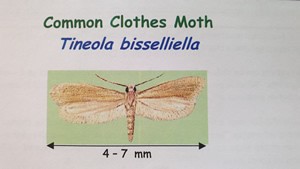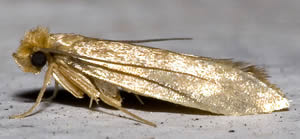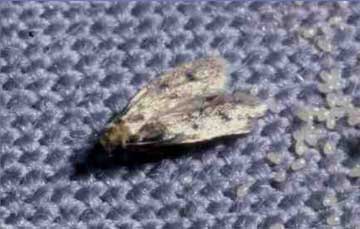Fact Sheets
Common Clothes Moth Pest Control Sydney Hills District
Tineola bisselliella


So what do moths eat in Sydney? “Your clothes” is the expected answer, but it is only the larvae that cause us problems, the adult moths only eat liquids such as nectar to hydrate their bodies and maintain energy stores.
Distribution and Habitat
Extensive distribution covering most of the globe, with the exception of the tropic. The clothes moth is relatively tolerant of low temperature, although it is considered to be an indoor pest. It is associated with natural and animal products such as fibre, fur, fertilisers, feathers, etc.
Biology
Females actively search for suitable sites for egg-laying such as natural fibre, cloth and wool. Larvae will generally emerge at temperatures above 10 degrees centigrade.
Moth infestation? Call us on 0417 251 911 or contact us online.
CASEMAKING CLOTHES MOTH PEST CONTROL
Tinea pellionella Linnaeus
[Lepidoptera: Tineidae]

“Infamous for damaging valuable and costly clothes you definitely don’t want these moths getting into your linen or stored clothes. A lot of damage to people’s clothes could’ve been prevented if they took a few simple steps or called a pest controller before things got out of hand. We’re a company that wants to help you as best we can and make sure no pests hassle you.” – Bruce Gow
Adult: Casemaking clothes moths in Sydney have a 9-16 mm wingspan. The body is covered in brown scales.
Head: The head is large and rounded. Antennae are long and thread-like (filiform). Eyes are small (less than half the size of the head).
Thorax: All legs are similar. The forewings are covered in brown scales with 3 dark spots sometimes prominent. Wings are held at right angles to the body at rest. Hindwings are similar to forewings but have a fringe of hairs on the posterior margin.
Abdomen: Cerci are absent.
Reproduction & Life-cycle:Adult stage from 42-130 days. Females lay sticky eggs with longitudinal ridges on the shell. Eggs adhere to the substrate. Egg stage 4-7 days. Larvae with legs, eyes and head capsule, typically caterpillar-like appearance. The larvae construct parchment-like cases which they carry while feeding and retreat into when disturbed. Larval stage 41-56 days. Pupation occurs in a cocoon formed from an enlarged case. Pupal stage 9-20 days.
Distribution:
A widespread, probably cosmopolitan larval pest of hair, hides, feathers and some plant material. More often a pest in domestic homes than commercial facilities.
Pest Status:
Adult males are active but females are sluggish. Larvae prefer fabric stained with fruit juices, or containing human sweat or urine for B-complex vitamins contained therein. Larvae can damage but not digest cotton and linen. Development, biology and anatomy resemble the Common Clothes moth but casemaking clothes moths carry webbing and are less common.
Biology:
Moths and butterflies make up the order Lepidoptera, and they are among the most familiar and easily recognized insects.
The Lepidoptera is defined as a monophyletic lineage by a suite of more than 20 derived features, the most obvious of which are the scales and proboscis.
The scales are modified, flattened hairs that cover the body and wings, shingle-like, and are the source of the extraordinary variety of colour patterns typical of these insects.
In all but the most primitive forms, feeding by adults is accomplished by pumping in liquid via a tubular proboscis (haustellum), which usually is elongate and coiled under the head.
The sister group of Lepidoptera, the Trichoptera (caddisflies), lack this development of mouthparts and the covering of scales and possess caudal cerci on the abdomen, which are not present in Lepidoptera.
Like other holometabolous insects, lepidopterans pass through egg, larval, pupal, and adult stages.
Mating and egg deposition are carried out by the adult moths and butterfl ies.
Within the eggs, embryos develop to fully formed larvae.
The larvae, commonly called caterpillars, feed and grow, which is accomplished by a series of stages (instars). At maturity they transform to pupae, usually within silken cocoons spun by the larvae, although many species pupate without a cocoon.
Metamorphosis to the adult occurs during the pupal stage, and the fully developed adult breaks the pupal shell to emerge. Adults of most species feed, but they do not grow.
Diapause, an arrested state of development, may occur in any of these stages, prolonging life and enabling the insect to bypass seasons that are unsuitable for growth and reproduction.
The Lepidoptera is one of the two or three largest orders of insects, with an estimated 160,000 named species.
Based on specimens in collections and extrapolating from recent studies of Central American moths, we believe that fewer than one-half of the known species have been named by taxonomists; even in North America, an estimated one-third of the fauna is undescribed.
Thus, a realistic projection of the total world Lepidoptera species number is not possible, but certainly it exceeds 350,000 and may be much larger.
Much of this diversity can be attributed to the radiation of species in association with flowering plants.
Lepidoptera represent the single most diverse lineage of organisms to have evolved primarily dependent upon angiosperm plants, and their numbers exceed those of the other major plant-feeding insects, Heteroptera, Homoptera, and Coleoptera (Chrysomeloidea and Curculionoidea).
Ring us up at A1 and we’ll sort you out with a quote or appointment in no time, we know you’re not in a mood to play games when it comes to pests and neither are we.
